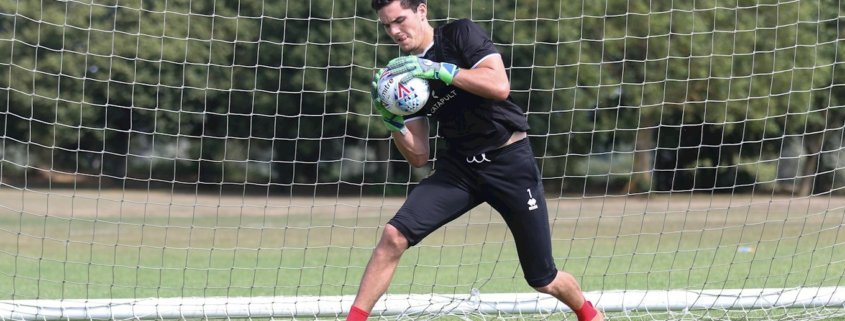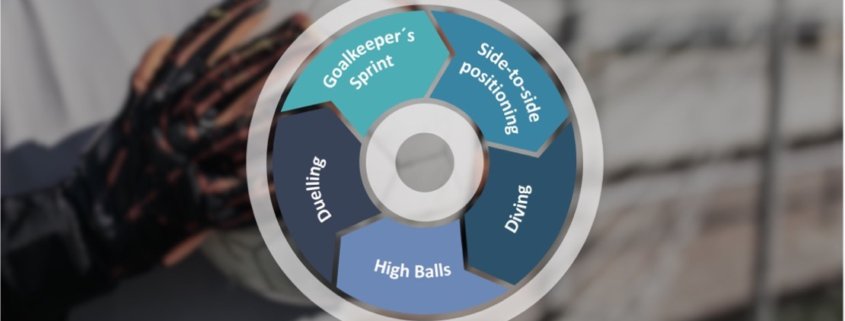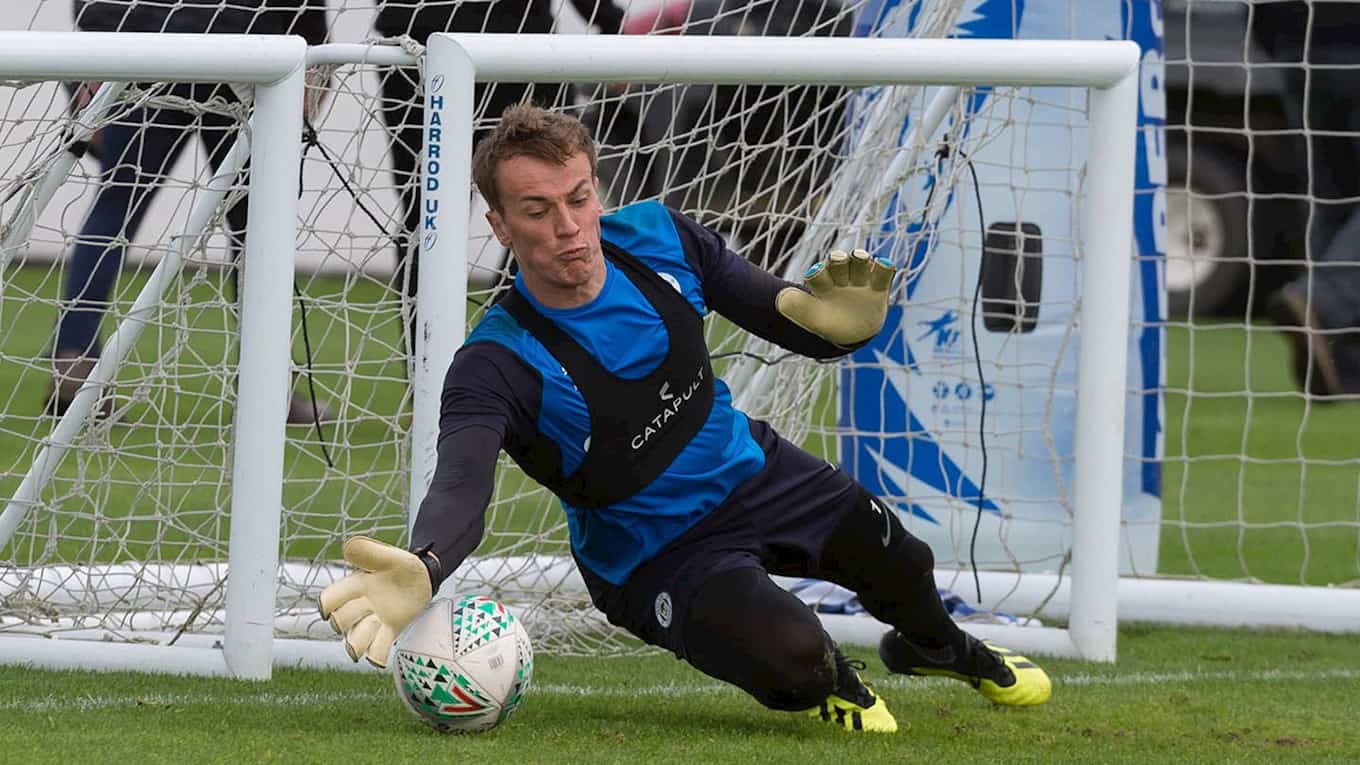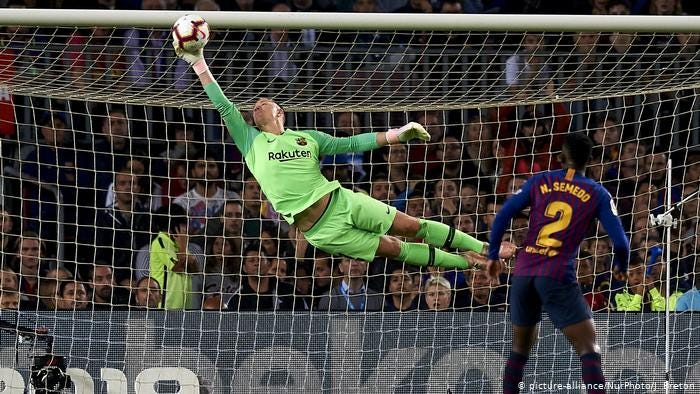Contents of article
- Summary
- The 5 key movement skills for goalkeepers
- Goalkeeper-specific speed: sprint and side-to-side positioning
- Improving the dive
- Developing high-ball jumping
- Increasing duelling strength
- Practical applications
Summary
There’s no denying it – outfield football players get most of the glory compared to goalkeepers. And while there are plenty of strength and conditioning (S&C) training recommendations and guidelines for outfield players, there is little published on goalkeeper-specific S&C training. That’s despite goalkeepers having a highly important role and requiring specific training – since their game demands are very different to outfield players.
Elite goalkeepers cover an average of 5000 m during a game, of which as much as 68 % is classified as low intensity and only ~ 0.8 % as high intensity, such as sprinting (>25.2 km/h) and high-speed running (HSR)(19.8-24.8 km/h). Elite goalkeepers generally have a total sprint distance of ~ 11 m, compared to ~ 97-313m for elite outfield players. They also perform ~ 56 m of HSR per game, in contrast to the considerably greater distances of ~ 500-1100 m in HSR executed by outfield players.
Even though the frequency of explosive actions is clearly far below what outfield players perform in an average game, the performance of goalkeepers is often seen as game-decisive.

The 5 key movement skills for goalkeepers
So it’s clear that goalkeepers and outfield players can’t be trained with a one-size-fits-all approach. Any training that aims to improve goalkeepers’ physical performance should be specific to the movement demands of goalkeeping. A general aim for the prescription of exercises is to achieve the so-called ‘transfer of training’ effect – where a high level of training specificity in a specific exercise leads to a higher likelihood of improved sporting performance. This is because the body adapts specifically to the demands placed on it by training, a concept widely known as: “Specific Adaptations to Imposed Demands”.
This article is a conscious attempt to bridge the gap between goalkeepers’ isolated technical training regime and their S&C training. It will be focused on strength, power and speed, and will categorise goalkeeper-specific S&C training into five different game-specific movement skills. It will also contain an in-depth technical analysis of each movement skill and provide accompanying practical exercise recommendations.
The five key movement skills categories have been selected based on research, my game observations as a retired goalkeeper, and my experience as an active S&C coach within an elite football environment. The movement skills have also been selected because they either appear frequently during games, are game-decisive, or both.
The five key movement skills are:
- Goalkeeper’s sprint
- Side-to-side positioning
- Diving
- High balls
- Duelling

1. Goalkeeper’s sprint
In a study investigating the frequency of different movements of professional goalkeepers leading into important technical actions, displacement (moving forward, sideways, or backward) was the most commonly occurring, followed by the not-so-frequent diving and jumping. Looking at the different movement directions of goalkeeper displacement, forward running is the most frequent, followed by lateral running. Further, the typical forward displacement of sprints was in the range of 0-5m.
So, we need to train our goalkeepers to be able to move powerfully and quickly in a linear (i.e., forward) fashion as well as laterally. A goalkeeper’s training regime should be heavily focused on short-distance acceleration-based speed training (i.e., 5m accelerations) and short-distance lateral change of direction. However, elements of longer distance sprints (>10m) should not be neglected.
2. Side-to-side positioning
Based on my game observations, there are two common lateral displacement actions for goalkeepers. These are the lateral shuffle and the cut – in this text, collectively referred to as side-to-side positioning. During the lateral cut, the outer leg (i.e., the opposite leg to the movement direction) is the primary leg being used to create force and, as a result, lateral displacement.
Training should also be predominantly unilateral. It is believed that unilateral training (training that involves one side of the body) is more effective than bilateral training (involving both sides of the body) in improving physical performance variables such as single-leg maximal strength, acceleration and change of direction speed.
Another factor to consider when choosing appropriate exercises to develop linear and lateral speed is the direction of forces being produced during explosive movements. Evidence suggests exercises with the same directions of force production as the targeted sport skill are more effective than exercises with different directions of force production. In a study with elite handball players, a horizontal plyometric training programme had greater improvements in horizontally dominated sport skills such as change of direction speed and acceleration, in comparison to a vertical plyometric training programme.
Furthermore, the available timeframes for maximal force production during the targeted sport skills should be considered when aiming for high training specificity. The force-velocity curve is a depiction of the relationship between force and velocity. It can be used to evaluate whether exercises are velocity-specific relative to a specific sports skill. The force-velocity relationship can be explained as “the slower a skeletal muscle shortens, the greater the force it can generate during contraction and vice versa”. So, the amount of time available to perform a task will dictate how much force can be produced.
With this information in mind, lateral movement exercises could be even more effective at developing acceleration or change of direction speed if the concept of specificity is appropriately considered.
3. Diving
A recent study investigated muscle activation patterns of goalkeepers during ‘diving saves’. It was found that dives towards the upper corner of the goal require high amounts of force and power during hip extension at push-off. While both far distance and high corner dives both require high power development during ankle plantarflexion (pushing the ground away with the foot). The authors also found that ankle plantar flexor muscles need to absorb lots of elastic energy, then immediately recoil back to release it (much like a rubber band being stretched and released) during high corner dives. Additionally, all far-distance dives require lots of force production during knee extension at push-off.
This suggests that power training involving the Gluteus Maximus, Gastrocnemius and Soleus (calf) muscles could prove helpful for goalkeepers when diving for high-corner balls. Plyometric training should also be a target to condition the ankle plantar flexors to assist with push-off. During long dives (where the goalkeeper has to reach out for the ball), power training involving the Quadriceps femoris and calf muscle groups is appropriate.
In the same study that investigated muscle activation patterns during ‘diving saves’, it was discovered that the ball-side leg (BS leg) produces more force (higher muscle activation) at high-corner or long dives and less force (lower muscle activation) at low-corner or short dives. According to the same authors, the BS leg is responsible for both the amount of power being produced and its direction during take-off in a diving save.
All of this indicates that when training horizontal lateral power (i.e., developing the physical attributes behind the diving action), exercises where the BS leg is the main ‘driver’ need to be prioritised.
4. High-balls
As mentioned earlier, goalkeepers don’t regularly perform vertical jumping during games. However, when they do, it could turn out to be game-decisive. Based on my game observations, goalkeepers most often tend to jump on one leg at set pieces or cross balls. The selected exercises should thus have more of a unilateral emphasis, as unilateral training seems to be most effective at improving unilateral movement skills.
The chosen exercises should also account for the force-vectors of the vertical jump. To rehash, a vertical plyometric training program is more effective than a horizontal plyometric program at improving vertically dominated sport skills – for example, a goalkeeper jumping up to punch out a cross ball.
The time available to create maximal force during a unilateral jump in a game could potentially be very different from situation to situation, and definitive research is lacking in this area. However, based on my own observations, most goalkeepers’ vertical jumps are performed with minimal knee and hip flexion at ground contact and with maximal effort – as the goalkeeper tends to prefer a high catch of the ball to avoid the attacker getting there first. This means that specific unilateral exercises could be appropriate, with short ground contact times or a small range of motion at knee and hip flexion. However, exercises involving a greater range of motion at the hip and knee joints should not be overlooked, as jumping from this position happens during a game, albeit less frequently.
5. Duelling
The last movement skill to scrutinise is duelling. This could be translated to the goalkeeper’s ability to use their body to protect the space within the penalty box. During open play, the numbers of players within the penalty box are generally few. However, during defensive set-pieces, there are often many opponents in the box, and this can make it difficult for the goalkeeper to get to the desired position from which to react. To be competitive in these tangled and somewhat chaotic situations, a strong, powerful core and upper body is necessary.
Not only does the upper body and core matter, but the whole kinetic chain needs to function properly, to transfer force from the feet up through the hips and core to the upper extremities. During a goalkeeper’s upper body-dominated activities, such as punching, throwing and pushing, the power produced by the upper body is very much the result of forces produced by the lower body, which are then transferred through the core up to the arms, via a “…muscle activation system known as the kinetic chain”.

Practical applications
This guide can be used to shape an S&C program for aspiring goalkeepers. However, individuality should not be neglected – all athletes have different physiological capacities, physical strengths or weaknesses and movement skills, to name a few. See Figure 2 for some examples of exercises to improve upon the five key movement skills discussed in this piece.
By using this guide, S&C coaches, goalkeeping coaches, and even ‘keepers themselves can hopefully start communicating and collaborating to find some common ground using the same terminology and language.
This guide can be used to help anyone create effective and inspiring training sessions for goalkeepers, where specific technical training and S&C training can be intertwined.
Alcazar, J., Csapo, R., Ara, I, & Alegre, L. M. (2019). On the Shape of the Force-Velocity Relationship in Skeletal Muscles: The Linear, the Hyperbolic, and the Double-Hyperbolic. Frontiers in physiology, 10, 769.
de Baranda, P, S., Ortega, E, & Palao, J, M. (2008). Analysis of goalkeepers’ defence in the World Cup in Korea and Japan in 2002. European Journal of Sport Science, 8. 127-134.
Dello Lacono, A., Martone, D., Milic, M, & Padulo, J. (2017). Vertical- vs. Horizontal Oriented Drop Jump Training: Chronic Effects on Explosive Performances of Elite Handball Players. Journal of strength and conditioning research, 31(4), 921–931.
Di Salvo, V., Benito, P, J., Calderón, F, J., Di Salvo, M, & Pigozzi, F. (2008). Activity Profile of Elite Goalkeepers During Football Match-play. Journal of Sports Medicine and Physical Fitness, 48(4), 443-446
Di Salvo, V., Baron, R., Gonzalez-Haro, C., Gormasz, C., Pigozzi, F, & Bachl, N. (2010). Sprinting analysis of elite soccer players during European Champions League and UEFA Cup matches. Journal of Sports Sciences. 28. 1489-94.
Dos Santos, T., Thomas, C., Jones, P, A, & Comfort, P. (2017). Mechanical determinants of faster change of direction speed performance in male athletes. Journal of Strength and Conditioning Research. Publish Ahead of Print, 1-22.
Dos Santos, T., McBurnie, A., Thomas, C., Comfort, P, & Jones, P. (2019). Biomechanical Comparison of Cutting Techniques: A Review AND Practical Applications. Strength and Conditioning Journal. Publish Ahead of Print. 1-28.
Ingebrigtsen, J., Dalen, T., Hjelde, G. H., Drust, B, & Wisløff, U. (2015). Acceleration and sprint profiles of a professional elite football team in match play. European Journal of Sport Science, 15(2), 101–110.
Kubayi, A. (2016). Analysis of Goalkeeper’s Game Performance at the 2016 European Football Championships. South African Journal of Sports Medicine, 32(1), 1-4.
Padulo, J., Haddad, M., Ardigo, L, P., Chamari, K, & Pizzolato, F. (2015). High frequency performance analysis of professional soccer goalkeepers: a pilot study. The Journal of Sports Medicine and Physical Fitness, 55(6), 557–562.
Pearson, D., Faigenbaum, A., Conley, M, & Kraemer, W. J. (2000). The National Strength and Conditioning Association’s basic guidelines for the resistance training of athletes. Strength and Conditioning Journal, 22(4), 14-30.
Ravé, G., Granacher, U., Boullosa, D., Hackney, A, C, & Zouhal, H. (2020). How to use global positioning systems (GPS) data to monitor training load in the “real world” of elite soccer. Frontiers in Physiology, 11(944), 1-11.
Sciascia, A, & Cromwell, R. (2012). Kinetic chain rehabilitation: a theoretical framework. Rehabilitation research and practice, 853037, 1-9.
Stern, D., Gonzalo-Skok, O., Loturco, I., Turner, A, & Bishop, C. (2020). A Comparison of Bilateral vs. Unilateral-Biased Strength and Power Training Interventions on Measures of Physical Performance in Elite Youth Soccer Players, Journal of Strength and Conditioning Research, 34(8), 2105-2111.
Matsukura, K. & Asai, T. (2019). Characteristics of lower limb force exertion during diving motions by collegiate male soccer goalkeepers. Science and Medicine in Football, 4, 1-8.
Wild, J., Bezodis, N., Blagrove, R. & Bezodis, I. (2011). A Biomechanical Comparison of Accelerative and Maximum Velocity Sprinting: Specific Strength Training Considerations. Professional Strength and Conditioning, 21, 23-36.



